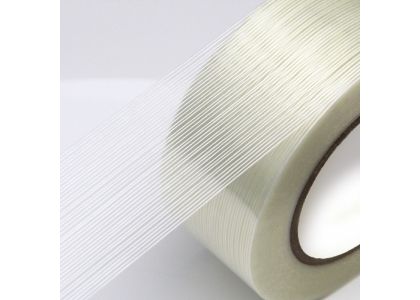
Insulation filament tape combines glass-fiber reinforcement with pressure-sensitive adhesives to deliver robust electrical insulation and mechanical stability in transformer windings and component assemblies. These tapes exhibit high dielectric strength, outstanding heat and solvent resistance, and superior tensile properties, making them ideal for securing windings in both dry-type and oil-filled transformers.Although they may carry a higher upfront cost, compliance with certifications such as UL 510, UL 1446, and IEC 60243, coupled with reduced maintenance needs, yields lower lifecycle expenses and enhanced reliability. Recent advances in bio-based backings, polyimide substrates (e.g., Kapton® and Upilex®), and smart self-monitoring features promise even greater performance and predictive-maintenance capabilities in next-generation electrical infrastructure.
Insulation filament tape is a specialized pressure-sensitive adhesive tape reinforced with glass fibers, designed to provide robust electrical insulation and mechanical support in transformer applications. This tape offers high dielectric strength, outstanding heat and solvent resistance, and superior tensile strength, making it ideal for securing windings and components in both dry-type and oil-filled transformers. By combining polyester film backings or polyimide materials with high-performance adhesives, manufacturers achieve thermal class ratings from Class B (130 °C) up to Class H (180 °C) and beyond, ensuring consistent performance under extreme temperatures. Proper application of insulation filament tape is essential to prevent electrical faults, reduce maintenance costs, and extend the operational lifespan of transformers. Proper selection and layering techniques ensure that tapes resist vibration, thermal cycling, and mechanical stress encountered during transformer operation. With advancements in substrate materials, such as polyimide films (e.g., DuPont™ Kapton® and UBE® Upilex®), the latest tape formulations deliver unparalleled stability and conformability.
Transformers rely on effective insulation to prevent short circuits and ground faults, which can lead to costly downtime and equipment damage.Insulation filament tape wraps around coil turns and securing components, forming a barrier that constrains electrical currents within designated pathways. In both dry-type transformers and oil-immersed units, tape selection and proper layer thickness are critical to maintain dielectric strength and mechanical integrity. Without effective insulation, the proximity of high-voltage windings poses a severe risk of corona discharge and partial discharges that can erode insulation over time. By incorporating reinforced filament tapes, engineers achieve both electrical and mechanical stabilization in compact transformer designs where space constraints are prominent.
High-quality filament tapes exhibit excellent heat resistance, with some products rated for continuous operation at temperatures up to 220 °C, preventing tape embrittlement and adhesive failure. The dielectric strength of these tapes often exceeds typical values for polyester films, ensuring reliable insulation under high-voltage stress. Mechanical reinforcement from fiberglass or aramid fibers also delivers high tensile strength, resisting tearing and tension during coil winding and operation. In addition to thermal resilience, these tapes exhibit excellent chemical resistance, safeguarding coil assemblies against solvents and contaminants. Manufacturers often conduct comprehensive thermal aging and dielectric loss tangent tests to validate long-term performance in power-class transformers.
Oil-resistant filament tapes use specialized acrylic or rubber adhesives that retain adhesion and dimensional stability when exposed to transformer oils and coolants. These tapes maintain their insulating properties and do not swell or degrade, even after thousands of operating hours in oil-filled environments.By preventing adhesive migration and substrate softening, oil-resistant variants reduce the risk of insulation breakdown and unplanned outages.Evaluations under mixed ester and silicone-based oils confirm that oil-resistant tapes maintain adhesive integrity, with minimal changes in peel adhesion after prolonged immersion tests.
While premium filament tapes may have a higher initial cost compared to conventional polyester tapes, their enhanced durability results in lower lifecycle expenses through reduced maintenance and downtime. Selection criteria should include international certifications such as UL 510, UL 1446 insulation system standards, IEC 60243 dielectric strength tests, and ISO 9001 quality management. Partnering with reputable manufacturers ensures consistency in tape thickness, adhesive quality, and batch traceability for critical transformer assemblies. Cost-benefit analyses reveal that premium filament tapes can reduce total cost of ownership by up to 25% through decreased maintenance frequency and extended transformer service life.
A leading utility operator reported a 30% decrease in transformer insulation faults after adopting high-strength filament tape rated for Class H applications. Electrical engineers often highlight the tape’s ease of application and improved mechanical support, noting fewer wrap failures during high-speed coil winding processes. In humid or dusty outdoor installations, contractors praise the moisture and abrasion resistance of filament tapes for extending service intervals. Utility maintenance teams emphasize the time savings achieved by the tape’s quick wrap application compared to traditional varnish or mastic methods. Several international operators report similar improvements in reliability metrics, reflecting the tape's global applicability.
Recent advancements include bio-based polyester backings and halogen-free adhesives, reducing environmental impact and aligning with RoHS and WEEE directives. Some manufacturers now offer tapes that incorporate recycled fibers and solvent-free adhesive formulations for greener transformer production. Eco-certified tapes not only support corporate sustainability goals but also meet the stringent performance benchmarks required in modern energy infrastructure. Certifications such as UL GREENGUARD and UL ECOLOGO are increasingly sought after by procurement teams aiming to minimize environmental footprints without sacrificing tape performance.
Emerging “smart tapes” embed fiber-optic or conductive threads capable of sensing temperature, strain, and aging within transformer windings. These intelligent tapes can provide real-time condition monitoring and predictive maintenance alerts, minimizing unplanned outages and optimizing asset management. Integration with IoT platforms and AI-driven analytics promises to revolutionize transformer health diagnostics and operational efficiency. Research into self-healing adhesives and embedded micro-sensors is underway, aiming to further enhance adhesion recovery and damage detection capabilities within transformer insulation systems.